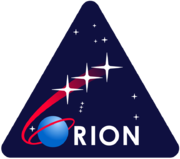Artemis II
| Operator | NASA |
|---|---|
| Spacecraft properties | |
| Spacecraft type | Orion MPCV |
| Start of mission | |
| Launch date | no later than April 2023[1] |
| Rocket | SLS Block 1B[2] |
| Launch site | Kennedy LC-39B[3] |
| End of mission | |
| Landing site | Pacific Ocean[4] |

Beyond Low Earth Orbit Program | |
The Exploration Mission 2 or EM-2 is scheduled to be the first crewed mission of NASA's Orion on the Space Launch System. The mission is to restart manned exploration of the Solar System. NASA plans to launch in 2023[1][5] with a crew to perform a practice flyby of a captured asteroid in lunar orbit.[6] This mission is expected to be the first time Americans have left low Earth orbit since Apollo 17 in December 1972.
Mission
EM-2 is a single-launch mission of a Space Launch System Block IB with an Exploration Upper Stage, lunar Block 1 Orion Multi-Purpose Crew Vehicle (MPCV) and a payload insertion of 50.7 t. It would be a ten- to fourteen-day mission with a crew of four astronauts who would spend four days in lunar orbit. Its current description is "Crewed mission to enter lunar orbit, test critical mission events, and perform operations in relevant environments". The target for EM-2, as of 2015, might be to perform a flyby of a captured asteroid in lunar orbit, to be conducted in 2023.[1]
References
- ^ a b c NASA delays Orion capsule's first manned flight until 2023
- ^ Bergin, Chris (February 23, 2012). "Acronyms to Ascent – SLS managers create development milestone roadmap". NASASpaceflight.com. Retrieved July 14, 2012.
- ^ Hill, Bill (March 2012). "Exploration Systems Development Status" (PDF). NASA Advisory Council. Retrieved July 21, 2012.
- ^ Bergin, Chris (June 14, 2012). "NASA teams evaluating ISS-built Exploration Platform roadmap". NASASpaceflight.com. Retrieved July 21, 2012.
- ^ "NASA Announces Next Steps on Journey to Mars: Progress on Asteroid Initiative". NASA. March 25, 2015. Retrieved March 25, 2015.
- ^ Foust, Jeff (March 25, 2015). "NASA Selects Boulder Option for Asteroid Redirect Mission". Space News. Retrieved March 27, 2015.

